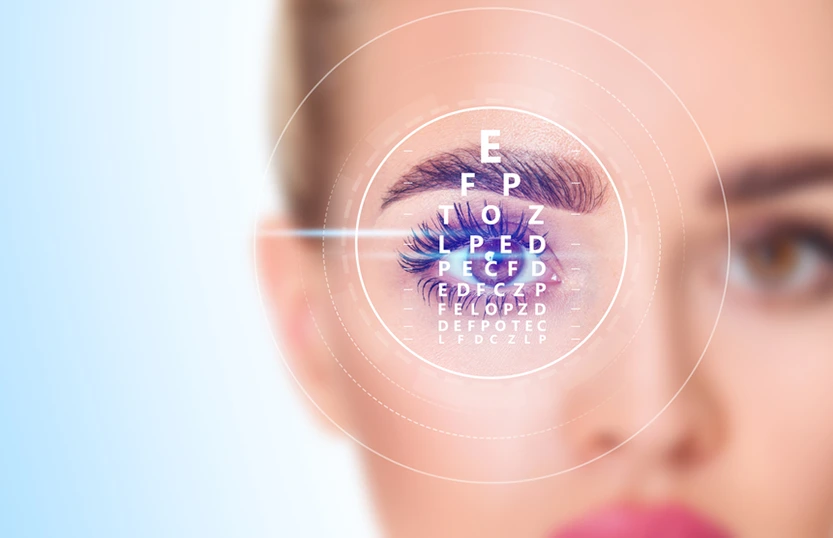For those seeking clear, glasses-free vision, modern vision correction surgery offers two main approaches: laser-based and lens-based procedures. LASIK, a laser procedure that reshapes the cornea, and EVO ICL™, a lens-based option that involves implanting a flexible collamer lens, are two of the most popular choices. Each procedure has unique benefits, making it easier for individuals to find a vision correction solution that suits their specific needs. This guide breaks down the differences between LASIK and EVO ICL, highlighting their advantages and helping you determine which option may be best for you.
LASIK: Laser-Based Vision Correction
LASIK, or Laser-Assisted In Situ Keratomileusis, is a laser-based procedure designed to correct refractive errors like nearsightedness, farsightedness, and astigmatism. LASIK works by reshaping the cornea, the transparent outer layer of the eye, which enhances its focusing ability and results in clearer vision.
Benefits of LASIK:
- LASIK provides quick results, with most patients noticing significantly improved vision within 24 to 48 hours.
- The procedure is fast, often completed in minutes, and requires minimal downtime, allowing most patients to return to their usual activities within a day or two.
- LASIK is highly effective for mild to moderate refractive errors, making it an excellent option for most people seeking to reduce or eliminate their dependence on corrective lenses.
LASIK Candidacy
LASIK is ideal for individuals over 18 who have stable vision, mild to moderate prescriptions, and a healthy cornea with adequate thickness. Many people considering vision correction surgery find LASIK to be a suitable and effective option. However, those with specific eye conditions, very high prescriptions, or thin corneas may need to explore other options.
Considerations
LASIK may not be recommended for people with very thin corneas, high refractive errors, or certain eye conditions affecting the cornea. In these cases, another approach, like EVO ICL, could be more suitable.
EVO ICL: Implantable Collamer™ Lens
EVO ICL is a lens-based procedure that corrects vision by implanting a thin, flexible collamer lens inside the eye. Unlike LASIK, which reshapes the cornea, EVO ICL provides vision correction by adding a removable lens in front of the natural one, similar to a permanent contact lens but without the need for daily maintenance.
Benefits of EVO ICL:
- High Prescription Support: EVO ICL is especially beneficial for individuals with high levels of myopia and those who may not be LASIK candidates due to thin corneas.
- Corneal Preservation: Since it doesn’t alter the shape of the cornea, EVO ICL is an excellent option for those with thin or irregular corneas.
- Reversibility: The lens can be removed if needed, providing flexibility for future vision adjustments.
- Enhanced Vision Quality: The collamer lens is designed to work seamlessly with the eye’s natural structures, providing clear, high-definition vision.
EVO ICL Candidacy
EVO ICL is a solid choice for patients with moderate to severe myopia, especially if LASIK isn’t suitable due to prescription strength or corneal thickness. Candidates should be over 18, have stable vision, and sufficient anterior chamber depth to safely accommodate the implantable lens.
Considerations
While EVO ICL offers long-term vision correction, the lens can be removed or adjusted if vision changes over time, providing a flexible option for evolving vision needs.
Comparing Key Factors: LASIK vs. EVO ICL
- Procedure Type: LASIK uses a laser to reshape the cornea, while EVO ICL involves placing a reversible lens implant inside the eye.
- Effectiveness for Different Vision Conditions: LASIK is typically effective for mild to moderate refractive errors, while EVO ICL works best for higher prescriptions and patients with thin or irregular corneas.
- Recovery Time: LASIK has a very short recovery time, with most patients resuming regular activities within a day or two. EVO ICL also involves minimal downtime, though mild discomfort is common in the first few days.
- Long-Term Results: Both procedures offer durable results. However, LASIK patients may still experience age-related changes over time. EVO ICL offers a reversible option for potential future adjustments, though this will require an additional surgical procedure.
How to Choose the Right Procedure
When deciding between LASIK and EVO ICL, several factors come into play, such as age, prescription strength, and overall eye health. LASIK can be an effective solution for patients with stable, mild to moderate refractive errors and healthy corneas. For individuals with high myopia, thin corneas, or certain eye health considerations, EVO ICL presents an excellent alternative with flexible, long-term benefits.
Consulting with a vision correction specialist can help clarify the best option based on your eye health, vision needs, and lifestyle.


